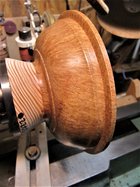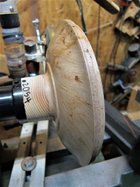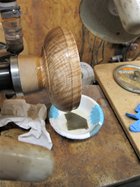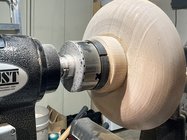Hi.
I have an elementary question regarding glued on tenons. I've been doing some skill building after a long absence from turning anything; to that end I'm making some small bowls out of some 8/4 KD stock (Cherry). I start out with a faceplate screwed to the face of the bowl and turn the base. Then for the first couple I turned a recess and chucked the base up in a chuck to turn the inside. The first problem I encountered was a bark inclusion that was not visible which split out the recess - catastrophic bowl failure! I then went to a glued on tenon as there isn't really enough material to turn one. I rough cut the tenon out of some 3/8 ash stock - around 2 to 2-1/2 inch diameter. I glued the tenon on the blank by centering with the tail stock center and then using the tail stock to clamp it in place. I figured 3/8 thick should be fine for work this size. Once the glue wad dry I trued up the tenon and then chucked it up and turned the front. I then reversed the bowl again (in a set of jumbo jaws), turned the tenon off and finished off the base. This seems to be working well and I believe I prefer it to a recess - seems to be easier and gets good results.
My question is with regard to my tenon material. What do you use for tenon material for glued on tenons? I believe I read that Odie uses construction lumber that is free from defects, so there is one possibility. Mostly I'm interested in the size/thickness of material used.
Any and all advice is appreciated. Thank you.
Be safe and stay well.
Barry W. Larson
Calgary, Alberta, Canada eh!
I have an elementary question regarding glued on tenons. I've been doing some skill building after a long absence from turning anything; to that end I'm making some small bowls out of some 8/4 KD stock (Cherry). I start out with a faceplate screwed to the face of the bowl and turn the base. Then for the first couple I turned a recess and chucked the base up in a chuck to turn the inside. The first problem I encountered was a bark inclusion that was not visible which split out the recess - catastrophic bowl failure! I then went to a glued on tenon as there isn't really enough material to turn one. I rough cut the tenon out of some 3/8 ash stock - around 2 to 2-1/2 inch diameter. I glued the tenon on the blank by centering with the tail stock center and then using the tail stock to clamp it in place. I figured 3/8 thick should be fine for work this size. Once the glue wad dry I trued up the tenon and then chucked it up and turned the front. I then reversed the bowl again (in a set of jumbo jaws), turned the tenon off and finished off the base. This seems to be working well and I believe I prefer it to a recess - seems to be easier and gets good results.
My question is with regard to my tenon material. What do you use for tenon material for glued on tenons? I believe I read that Odie uses construction lumber that is free from defects, so there is one possibility. Mostly I'm interested in the size/thickness of material used.
Any and all advice is appreciated. Thank you.
Be safe and stay well.
Barry W. Larson
Calgary, Alberta, Canada eh!




